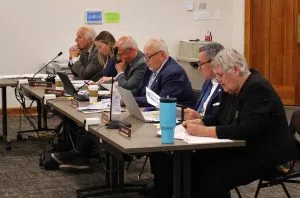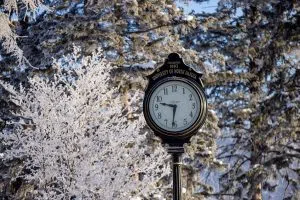
Lawmakers on the Legislative Procedure and Arrangements Committee meet July 11, 2024, at the Capitol. The committee is studying the impact of term limits and possible ways to streamline processes to reduce the burden on staff. Pictured are, from front, Sen. Kathy Hogan, Sen. David Hogue, Rep. Glenn Bosch, Sen. Ron Sorvaag, Rep. Emily O’Brien and Rep. Dennis Johnson. (Mary Steurer/North Dakota Monitor)
(North Dakota Monitor) -North Dakota lawmakers have already requested 422 bills and resolutions to be drafted for the 2025 legislative session, double the number requested at this time two years ago, Legislative Council staff say.
Prior to the 2023 legislative session, lawmakers didn’t hit 400 bill drafts until Nov. 28, 2022, said Legislative Council Director John Bjornson.
“We’re double the pace but we haven’t even hit the heavy drafting periods,” Bjornson told members of the Legislative Procedure and Arrangements Committee earlier this month.
The pace is making it difficult for Legislative Council staff to keep up, causing delays in providing amendments to lawmakers, said Emily Thompson, legal division director for Legislative Council.
The interim legislative committee has been studying the impact of lawmaker term limits and looking for ways to streamline processes. As lawmakers are limited to serving no more than eight years in each chamber due to a measure approved by voters in 2022, the increased turnover is expected to increase the burden on legislative staff.
One area the committee has discussed is how to avoid duplication of bill drafts on similar topics. But a lack of transparency makes that challenging.
Under North Dakota law, bill drafts and communications between Legislative Council staff and legislators are not subject to disclosure. That makes it hard for lawmakers to know if another legislator has requested a bill draft on the same topic.
Committee Chair Sen. Jerry Klein, R-Fessenden, said he typically doesn’t know if another lawmaker is working on a similar proposal unless he hears it through the grapevine.
“You might hear it at the lounge that evening,” Klein said. “There’s got to be a better way to do this.”
If a legislator requests a bill draft on a topic that’s already being addressed by another lawmaker, Legislative Council staff will inform them there’s a similar proposal and ask if they can provide the lawmaker’s name so they could potentially work together, Bjornson said.
“We’re seeing a much greater reluctance to do that now,” Bjornson told the committee.

He said the reluctance is likely due to term limits reducing a lawmaker’s time to make an impression.
Committee member Sen. Kathy Hogan, D-Fargo, questioned whether the policy is good transparency practice.
“This seems like pretty basic information,” Hogan said.
By contrast, bill drafts requested by Montana lawmakers are public on a legislative website, Bjornson said.
The committee has also discussed other ways to streamline processes, such as addressing how many bill drafts a lawmaker can request or adjusting the timeline for making requests. The committee has not made any recommendations, but may meet one more time before the 2025 session.
During the 2023 regular legislative session, 1,230 bills and resolutions were drafted, with 990 of those introduced, according to Legislative Council. A total of 585 bills became law and 40 resolutions passed.
The average number of bill drafts requested per legislator has trended up in the last decade, with about 10 bill drafts per lawmaker in 2023 compared to seven in 2013, a Legislative Council analysis shows. Nine lawmakers requested 21 or more bill drafts in 2023.









